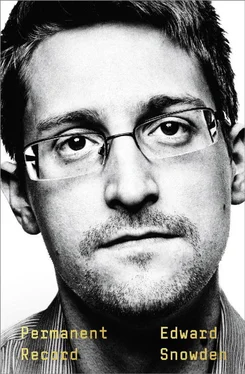Though I felt some relief once I’d resolved to disclose directly to journalists, I still had some lingering reservations. Most of them involved my country’s most prestigious publications—particularly America’s newspaper of record, the New York Times. Whenever I thought about contacting the Times , I found myself hesitating. While the paper had shown some willingness to displease the US government with its WikiLeaks reporting, I couldn’t stop reminding myself of its earlier conduct involving an important article on the government’s warrantless wiretapping program by Eric Lichtblau and James Risen.
Those two journalists, by combining information from Justice Department whistleblowers with their own reporting, had managed to uncover one aspect of STELLARWIND—the NSA’s original-recipe post-9/11 surveillance initiative—and had produced a fully written, edited, and fact-checked article about it, ready to go to press by mid-2004. It was at this point that the paper’s editor in chief, Bill Keller, ran the article past the government, as part of a courtesy process whose typical purpose is for a publication’s editorial staff to have a chance to assess the government’s arguments as to why the publication of certain information might endanger national security. In this case, as in most cases, the government refused to provide a specific reason, but implied that one existed and that it was classified, too. The Bush administration told Keller and the paper’s publisher, Arthur Sulzberger, without providing any evidence, that the Times would be emboldening America’s enemies and enabling terror if it went public with the information that the government was wiretapping American citizens without a warrant. Unfortunately, the paper allowed itself to be convinced and spiked the article. Lichtblau and Risen’s reporting finally ran, but over a year later, in December 2005, and only after Risen pressured the paper by announcing that the material was included in a book of his that was about to be released. Had that article run when it was originally written, it might well have changed the course of the 2004 election.
If the Times , or any paper, did something similar to me—if it took my revelations, reported on them, submitted the reporting for review, and then suppressed its publication—I’d be sunk. Given the likelihood of my identification as the source, it would be tantamount to turning me in before any revelations were brought to the public.
If I couldn’t trust a legacy newspaper, could I trust any institution? Why even bother? I hadn’t signed up for any of this. I had just wanted to screw around with computers and maybe do some good for my country along the way. I had a lease and a lover and my health was improved. Every STOP sign on my commute I took as advice to stop this voluntary madness. My head and heart were in conflict, with the only constant being the desperate hope that somebody else, somewhere else, would figure it out on their own. After all, wasn’t journalism about following the bread crumbs and connecting the dots? What else did reporters do all day, besides tweet?
I knew at least two things about the denizens of the Fourth Estate: they competed for scoops, and they knew very little about technology. It was this lack of expertise or even interest in tech that largely caused journalists to miss two events that stunned me during the course of my fact-gathering about mass surveillance.
The first was the NSA’s announcement of the construction of a vast new data facility in Bluffdale, Utah. The agency called it the Massive Data Repository, until somebody with a knack for PR realized the name might be tough to explain if it ever got out, so it was renamed the Mission Data Repository—because as long as you don’t change the acronym, you don’t have to change all the briefing slides. The MDR was projected to contain a total of four twenty-five-thousand-square-foot halls, filled with servers. It could hold an immense amount of data, basically a rolling history of the entire planet’s pattern of life, insofar as life can be understood through the connection of payments to people, people to phones, phones to calls, calls to networks, and the synoptic array of Internet activity moving along those networks’ lines.
The only prominent journalist who seemed to notice the announcement was James Bamford, who wrote about it for Wired in March 2012. There were a few follow-ups in the nontech press, but none of them furthered the reporting. No one asked what, to me at least, were the most basic questions: Why does any government agency, let alone an intelligence agency, need that much space? What data, and how much of it, do they really intend to store there, and for how long? Because there was simply no reason to build something to those specs unless you were planning on storing absolutely everything, forever. Here was, to my mind, the corpus delicti—the plain-as-day corroboration of a crime, in a gigantic concrete bunker surrounded by barbed wire and guard towers, sucking up a city’s worth of electricity from its own power grid in the middle of the Utah desert. And no one was paying attention.
The second event happened one year later, in March 2013—one week after Clapper lied to Congress and Congress gave him a pass. A few periodicals had covered that testimony, though they merely regurgitated Clapper’s denial that the NSA collected bulk data on Americans. But no so-called mainstream publication at all covered a rare public appearance by Ira “Gus” Hunt, the chief technology officer of the CIA.
I’d known Gus slightly from my Dell stint with the CIA. He was one of our top customers, and every vendor loved his apparent inability to be discreet: he’d always tell you more than he was supposed to. For sales guys, he was like a bag of money with a mouth. Now he was appearing as a special guest speaker at a civilian tech event in New York called the GigaOM Structure: Data conference. Anyone with $40 could go to it. The major talks, such as Gus’s, were streamed for free live online.
The reason I’d made sure to catch his talk was that I’d just read, through internal NSA channels, that the CIA had finally decided on the disposition of its cloud contract. It had refused my old team at Dell, and turned down HP, too, instead signing a ten-year, $600 million cloud development and management deal with Amazon. I had no negative feelings about this—actually, at this juncture, I was pleased that my work wasn’t going to be used by the agency. I was just curious, from a professional standpoint, whether Gus might obliquely address this announcement and offer any insight into why Amazon had been chosen, since rumors were going around that the proposal process had been rigged in Amazon’s favor.
I got insight, certainly, but of an unexpected kind. I had the opportunity of witnessing the highest-ranking technical officer at the CIA stand onstage in a rumpled suit and brief a crowd of uncleared normies—and, via the Internet, the uncleared world—about the agency’s ambitions and capacities. As his presentation unfolded, and he alternated bad jokes with an even worse command of PowerPoint, I grew more and more incredulous.
“At the CIA,” he said, “we fundamentally try to collect everything and hang on to it forever.” As if that wasn’t clear enough, he went on: “It is nearly within our grasp to compute on all human generated information.” The underline was Gus’s own. He was reading from his slide deck, ugly words in an ugly font illustrated with the government’s signature four-color clip art.
There were a few journalists in the crowd, apparently, though it seemed as if almost all of them were from specialty tech-government publications like Federal Computer Week. It was telling that Gus stuck around for a Q & A toward the conclusion of his presentation. Rather, it wasn’t quite a Q & A, but more like an auxiliary presentation, offered directly to the journalists. He must have been trying to get something off his chest, and it wasn’t just his clown tie.
Читать дальше












